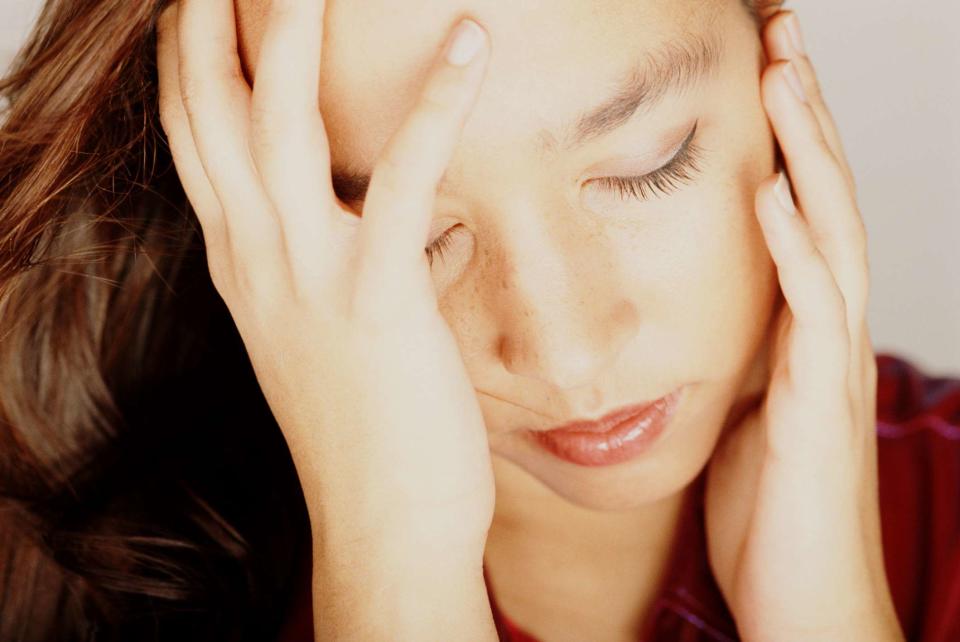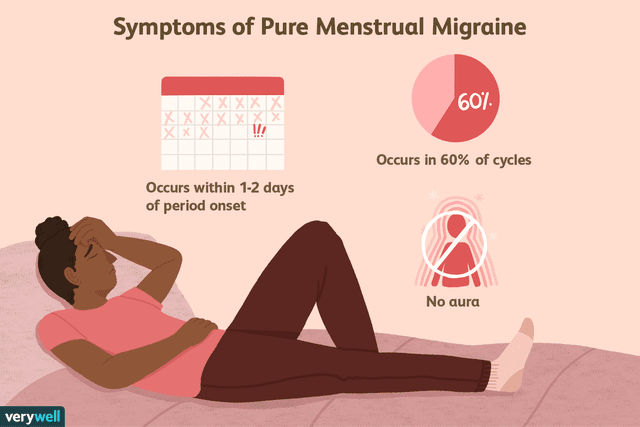An Overview of Menstrual Migraines
These episodes occur before and during your period

If you find that your migraines occur most frequently right before or at the start of your period, last longer, and are more severe and less responsive to typical migraine medications, you most likely have what are called menstrual migraines. According to the National Headache Foundation, migraines occur in women three times more frequently than in men, and menstrual migraines affect 60 percent of these women. Among females with migraines, attacks are about two to three times more likely to occur during menstruation than at other times during their cycles.

Symptoms
There are two sub-types of menstrual migraines: Menstrual-related migraines and pure menstrual migraines, with the former being more common than the latter.
Symptoms of menstrual-related migraines include:
A migraine headache without aura that occurs one to days before or after the onset of your period and occurs in more than 60 percent of your cycles
Migraines with or without aura that occur at other times in your cycle
Symptoms of a pure menstrual migraine include:
A migraine headache without aura that occurs exclusively during the one or two days before or after the onset of your period and occurs in more than 60 percent of your cycles
Pure menstrual migraines occur in only about 10 percent of women with menstrual migraines, making them much less common than menstrual-related migraines.
According to the American Headache Society, pure menstrual migraines without aura occur in 7 percent to 19 percent of women with migraines. Menstrual-related migraines without aura occur in 35 percent to 51 percent of women with migraines.
Either type of menstrual migraine can occur in isolation or can be one of the complaints of premenstrual syndrome (PMS). Other PMS symptoms include nausea, bloating, breast tenderness, and mood swings.
Menstrual migraines can also be associated with painful periods.
Causes
Researchers have found a strong connection between estrogen and migraine headaches, which is why women tend to be more prone to migraines than men.
Typically, higher estrogen levels will prevent migraine headaches, whereas lower estrogen levels can trigger them. But it may be more the fluctuation or change in estrogen that triggers a migraine, not simply the fact that the level is low. That said, because a woman’s estrogen levels drop to their lowest point when she is menstruating, this is usually the time that migraines are most likely to occur.
Furthermore, the presence of estrogen is associated with increased levels of serotonin in the brain—hence, a decline in estrogen may be accompanied by a decrease in serotonin. Researchers believe that fluctuations in serotonin levels play a role in triggering migraines.
Diagnosis
There are no tests to confirm a diagnosis of menstrual migraine, so the best thing to do is to keep a diary for at least three months, recording both your migraine attacks and the days you menstruate, as well as any migraine symptoms that occur during other times in your cycle.
Your healthcare provider can then review this information and see how it compares to the symptom criteria for each type of menstrual migraine (see above) to come to a diagnosis.
Related:How to Keep Track of Your Menstrual Cycle
Treatment
There are three treatment strategies to treat menstrual migraines:
Enhanced acute treatment: This approach involves taking fast-acting triptans (such as zolmitriptan or sumatriptan) and a non-steroidal anti-inflammatory drug (NSAID) taken early in the migraine. Calcitonin gene-related peptide antagonists (CGRPs), including Ubrelvy (ubrogepant), Nurtec ODT (rimegepant), and Zavzpret (zavegepant), are other options.
Mini-prophylaxis: With this, you take NSAIDs or certain triptans right before the onset of menstrual bleeding.
Continuous prevention: The most common of these strategies is continuous use of the oral contraceptive pill. Not only does this inhibit ovulation, (the trigger for the hormone changes), it also maintains estrogen levels by eliminating the hormone-free week associated with the cyclic use of the birth control pill.
Learn More:Using Birth Control for Menstrual Migraines
Keep in mind, though, that every woman’s body responds to hormones differently. In addition, there are side effects and contraindications involved in using birth control pills that may make it an inappropriate treatment for some women. Taking estrogen, for example, may increase the risk of stroke in women with migraine with aura.
You may need to try a few different birth control methods before finding one that reduces or eliminates menstrual migraines for you. This is why some healthcare providers may advise using birth control with fewer placebo days, using estrogen birth control patches during the placebo week, or using progestin-only birth control to prevent menstrual migraines.
Learning to recognize other migraine triggers, such as stress, lack of sleep, or irregular eating, can also help to prevent menstrual migraines. Complementary and alternative medical options are also available.
Related:Can Birth Control Pills Stop Menstrual Migraines?
A Word From Verywell
Menstrual migraines, like all migraines, can be painful and disruptive, especially if you already experience other pre-menstrual symptoms. Fortunately, there are numerous treatment options available, though it may require a bit of patience and some trial and error to find the one that's right for you.

